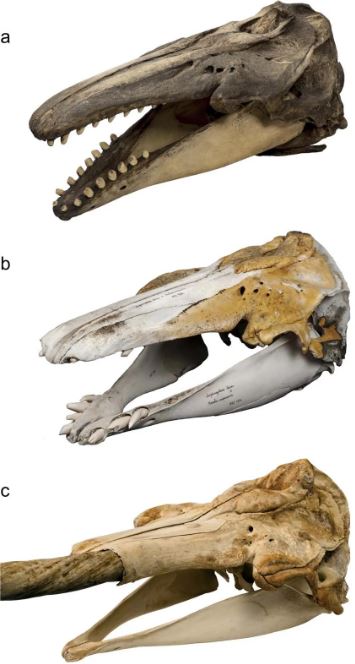Belugas and Narwhals
Family Monodontidae
Mammalian Hybrids
Delphinapterus leucas [Beluga]
× Tursiops truncatus [Common Bottle-nosed Dolphin] NHR?? Post (2001) suggests an aberrant fossil atlas (Late Pleistocene-Early Holocene) from the North Sea might be the result of a “liaison between a white whale (Delphinapterus leucas) and a bottle-nose dolphin (Tursiops truncatus).” T. truncatus is assigned to family Delphinidae, so this would be an interfamilial cross.
× Monodon monoceros [Narwhal] NHR. CON: Arctic Ocean. Heide-Jørgensen and Reeves (1993) described and discussed the skull of a probable hybrid from Disko Bay, West Greenland (68˚50´N, 53˚10´W). It was shot offshore in mid-May of 1986 or 1987 by an Inuit hunter who kept only its skull. Though the skull is larger than those of normal narwhals and belugas, Heide-Jørgensen and Reeves asserted (p. 258) that “the intermediate characteristics of the skull and dentition are consistent with the hypothesis that the anomalous whale was a narwhal-beluga hybrid.” Its large size, then, would have been due to heterosis. They went on to say that, according to the hunter, “the intact animal looked like a combination of narwhal and beluga, with the tail of a narwhal and pectoral flippers resembling those of a beluga.” Most conceptions for both beluga and narwhal occur in April-May, a season when both are abundant off West Greenland. The specimen was in the Greenland Fisheries Research Institute, Copenhagen (no. 361), so genetic testing of the specimen was possible, and using such methods, Skovrind et al (2019) showed that the animal was in fact a first-generation male beluga-narwhal hybrid with a narwhal mother. The various supposed pictures seen around the Internet showing this hybrid as a living animal are apparently all fakes since the only known specimen is the skull (shown below). See also: Kelly et al. 2010.

By the same author: Handbook of Avian Hybrids of the World, Oxford University Press (2006).